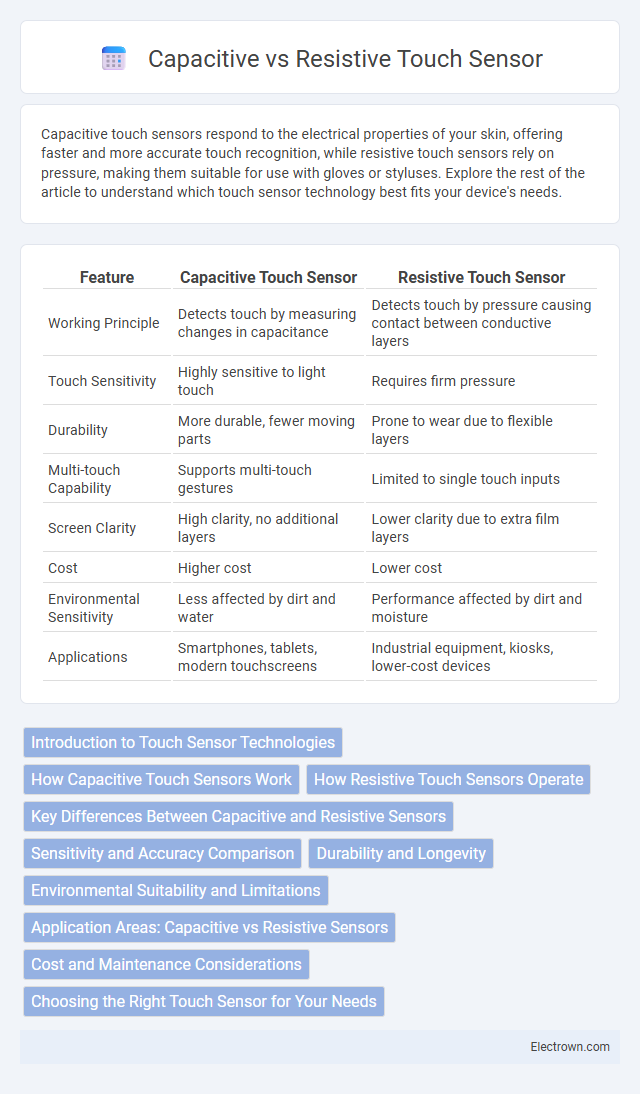Capacitive touch sensors respond to the electrical properties of your skin, offering faster and more accurate touch recognition, while resistive touch sensors rely on pressure, making them suitable for use with gloves or styluses. Explore the rest of the article to understand which touch sensor technology best fits your device's needs.
Table of Comparison
| Feature | Capacitive Touch Sensor | Resistive Touch Sensor |
|---|---|---|
| Working Principle | Detects touch by measuring changes in capacitance | Detects touch by pressure causing contact between conductive layers |
| Touch Sensitivity | Highly sensitive to light touch | Requires firm pressure |
| Durability | More durable, fewer moving parts | Prone to wear due to flexible layers |
| Multi-touch Capability | Supports multi-touch gestures | Limited to single touch inputs |
| Screen Clarity | High clarity, no additional layers | Lower clarity due to extra film layers |
| Cost | Higher cost | Lower cost |
| Environmental Sensitivity | Less affected by dirt and water | Performance affected by dirt and moisture |
| Applications | Smartphones, tablets, modern touchscreens | Industrial equipment, kiosks, lower-cost devices |
Introduction to Touch Sensor Technologies
Capacitive touch sensors detect changes in electrical fields caused by the conductive properties of the human finger, offering high sensitivity and multi-touch capabilities. Resistive touch sensors operate through pressure-induced contact between two conductive layers, making them responsive to any input object but less sensitive and more prone to wear. These fundamental differences influence applications in smartphones, industrial controls, and public kiosks, where durability and user interaction vary in priority.
How Capacitive Touch Sensors Work
Capacitive touch sensors operate by detecting changes in the electrical field when your finger approaches the screen, altering the sensor's capacitance. The sensor consists of an insulating layer coated with a transparent conductor, which stores electrical charge and measures fluctuations caused by the conductive properties of your skin. This technology enables highly responsive and accurate touch detection, making capacitive sensors ideal for smartphones, tablets, and other modern touch-enabled devices.
How Resistive Touch Sensors Operate
Resistive touch sensors operate by detecting pressure applied to their surface, consisting of two flexible layers separated by a small gap. When you press the screen, the layers make contact, creating an electrical connection that determines the touch location through changes in resistance. This technology enables accurate input regardless of whether you use a finger, stylus, or gloved hand.
Key Differences Between Capacitive and Resistive Sensors
Capacitive touch sensors detect touch through changes in the electrical field caused by the conductive properties of the human skin, offering higher sensitivity and multi-touch support. Resistive touch sensors operate by pressure, relying on the physical contact between two conductive layers, making them more suitable for use with gloves or styluses. Your choice between these sensors depends on factors such as durability, environmental conditions, and input type requirements.
Sensitivity and Accuracy Comparison
Capacitive touch sensors offer higher sensitivity and accuracy by detecting changes in the electrical field caused by the conductive properties of your skin, enabling precise multi-touch input. Resistive touch sensors rely on pressure to register input, providing less sensitivity and lower accuracy, especially for light or glancing touches. For applications requiring precise and responsive touch detection, capacitive sensors generally outperform resistive ones, delivering better user experience.
Durability and Longevity
Capacitive touch sensors generally offer superior durability and longevity due to their solid-state design, which lacks moving parts and is less prone to wear from repeated use. Resistive touch sensors, comprising multiple flexible layers, tend to degrade faster as constant pressure can cause these layers to wear, leading to decreased sensitivity and accuracy over time. Choosing capacitive technology for your device enhances reliability and extends operational life in high-use environments.
Environmental Suitability and Limitations
Capacitive touch sensors excel in clean, dry environments with minimal interference, making them ideal for consumer electronics and indoor use, but they struggle with water, gloves, and extreme temperatures. Resistive touch sensors perform reliably in harsh conditions, including wet or dirty surfaces, and operate well with gloves or styluses, though they may offer less sensitivity and multi-touch capability. Your choice depends on the environmental demands and interaction methods expected for the device.
Application Areas: Capacitive vs Resistive Sensors
Capacitive touch sensors dominate in smartphones, tablets, and interactive kiosks due to their high sensitivity and multi-touch capabilities, making them ideal for consumer electronics and modern user interfaces. Resistive touch sensors are commonly used in industrial machinery, medical devices, and environments where gloves or styluses are necessary because they respond to pressure and are more durable under harsh conditions. Both technologies serve distinct application areas based on accuracy, environmental resistance, and user interaction needs.
Cost and Maintenance Considerations
Capacitive touch sensors generally have a higher initial cost compared to resistive touch sensors but offer lower maintenance expenses due to their durability and resistance to wear. Resistive touch sensors are more affordable upfront but often require more frequent replacement or recalibration because their layered design is susceptible to damage from scratches and pressure. Your choice should weigh the balance between upfront investment and long-term maintenance requirements for optimal cost efficiency.
Choosing the Right Touch Sensor for Your Needs
Capacitive touch sensors offer high sensitivity and multi-touch capabilities, making them ideal for smartphones and tablets with smooth glass surfaces. Resistive touch sensors provide reliable performance in harsh environments and support input with gloves or styluses, often used in industrial applications. Your choice depends on factors like durability, input method, and the operational environment to ensure optimal functionality.
Capacitive vs Resistive Touch Sensor Infographic

 electrown.com
electrown.com